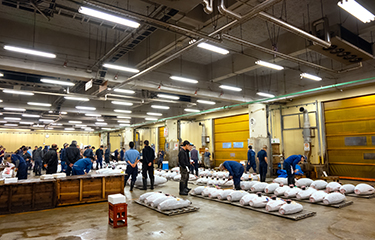Price of Japan’s top tuna highlights country’s recovery from Covid-19

The top bluefin tuna sold during the first auction of the year at Tokyo’s Central Wholesale Market in Toyosu reached JPY 36,040,000 (USD 274,120, EUR 256,785), carrying on a tradition started at the market’s former location in Tsukiji and signaling some recovery from the pandemic.
The high price has nothing to do with the actual value of tuna, nor with its relative scarcity. As in years past, it’s a PR stunt and a reasonably inexpensive way for the purchaser to get worldwide name recognition.
This year’s top tuna weighed 212 kilograms, and the successful bidder – for the third year in a row – was Yamayuki, an midsize wholesaler in Tokyo that supplies tuna to high-end sushi shops.
The price was a significant rise from the last two years, when prices fell from the stratosphere to a mere JPY 20,840,000 (USD 158,342, EUR 148,276) in 2020 and JPY 16,880,000 (USD 128,169, EUR 120,016) in 2021. At the time, it didn’t make sense for sushi chains and distributors to spend big on advertising while the Japanese government was discouraging people from eating out in order to contain the spread of Covid-19.
That price is still a far cry from the record-high price the tuna reached in 2019, when it garnered JPY 333 million (then USD 3 million, EUR 2.6 million) – which the buyer said he regretted paying.
But this year’s higher price is still an indication that life is going back to normal in Japan, even though the pandemic hasn’t been contained. Japan is in the midst of a sixth wave of infection, with daily cases reaching 245,542, and daily deaths reaching 456 on 6 January. However, the government has switched its tack, and is lifting anti-Covid measures. The policy, labeled “With Corona,” means living with Covid-19, the same way people live with other risks like influenza, while taking reasonable precautions.
At restaurants in Japan, there are still temperature checks. Alcohol disinfectant sprays are still available, and mask-wearing is still advised indoors and commonly practiced when not eating and drinking. But people are patronizing restaurants again, and company parties are being held as before the pandemic.
This year, as every year, the top tuna was from Oma, a fishing port in Aomori, at the northern tip of Honshu Island. The Oma Fisheries Cooperative Association members managed to garner fame and reward for multiple reasons – part of which is serendipity.
Another break came when Japan’s national public television channel, NHK, ran a popular drama set in Oma from 3 April to 30 September, 2000. It became a hot topic across the country because it was the first time a continuing drama in Japan featured a single mother.
In the show, called “Watashi No Aozora” (My Blue Sky), the heroine’s father is an Oma tuna fisherman, and his wife is active in the fishermen’s cooperative. So the setting of the series introduced Japanese people to the drama of landing giant tuna by the “ippon zuri” (or single-line) method, and the special qualities of Oma tuna.
In the 2001 auction that followed the series, a 202-kilogram Pacific bluefin tuna sold at Tokyo's Tsukiji Fish Market auction for JPY 20.2 million (USD 152,914, EUR 142,975 at today’s rate) making it the most-expensive fish ever sold at the time, and supercharging the fame of both the auction event and the Oma brand.
That begs the question of whether Oma tuna is actually better than tuna from other regions – but Japanese tuna experts said there is good reason Oma tuna is held up as the best.
Oma faces the Tsugaru Strait, which links the Sea of Japan with the Pacific Ocean. Three currents converge there, and as a result the area is rich in plankton, which feeds squid and Pacific saury, in turn providing a surplus of feed for the tuna to feast on and grow fat. From August to January, tuna migrate to the Tsugaru Strait from both the Japan Sea and the Pacific Ocean. The temperatures are extremely cold in the fall and winter, so the tuna carry a heavy fat cover to survive. From October to December, they are at their fattiest.
Tuna weighing over 30 kilograms can receive the Oma tuna mark on the cheek. The stickers have a serial number indicating which boat caught the tuna, when the tuna was caught, and the method used to catch it.
There are other local ports with their own brands, including Fukaura Tuna and Sanmaya Tuna, and all sell their bluefin tuna catch for high prices, but the ones that go for the most are those caught with the ippon zuri method, rather than the other main method of longline.
Ippon zuri, as practiced in Oma, might be called a “handline,” but in the modern version, a mechanical spool helps reel in the fish, while in the last decade, an electric shocker has been added to the process to stun the fish before it is harpooned and hauled aboard with a winch and laid gently on a foam pad. The slow one-by-one method allows capturing the fish without bruising. Ippon zuri is also used to describe “pole-and-line” fishing for bonito, but in this context, there are usually many poles used at the same time and the fish are pulled up one after the other in quick succession.
At the Toyosu auction, even for fish other than the top tuna, Aomori origin bluefin sells higher. On the same day, 5 January, the low price per kilogram for Aomori bluefin was JPY 4,320 (USD 32.74, EUR 30.45), while that from various other origins was JPY 3,780 (USD 28.64, EUR 26.64). On 30 December, the high and low prices for Aomori-origin tuna were JPY 7,020 and JPY 5,400 (USD 53.19 and USD 40.92, EUR 49.49 and EUR 38.07) while those for various other origins were JPY 6,480 and JPY 3,200 (USD 49.07 and USD 24.29, EUR 45.68 and EUR 22.56).
Photo courtesy of cowardlion/Shutterstock






Share